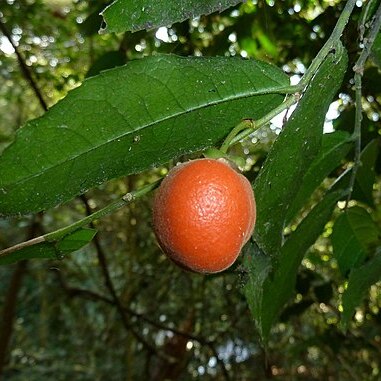A shrub or small slender tree up to 6 m.. Bark smooth, grey.. Twigs greyish brown.. Young shoots and petioles pubescent.. Buds perulate; perulae broadly ovate, up to 5 mm. long, subscarious, closely longitudinally striate-nerved, ciliolate.. Petioles 2–4 mm. long; leaf-blade oblong-lanceolate or ovate-lanceolate, 4–10 cm. long, 2–4 cm. wide, acutely or subacutely acuminate, obliquely shallowly cordate, sharply serrate, the teeth gland-tipped, coriaceous, somewhat shiny above, lateral nerves 8–11 pairs, 3–4 of these somewhat crowded at the base, looped within the margin, tertiary nerves reticulate, more prominent beneath than above, pubescent on the midrib above and beneath at first, otherwise quite glabrous.. Stipules lanceolate, 5–8 mm. long, fimbriate towards the base, striate-nerved, fairly readily caducous.. Flowers axillary, solitary.. Male flowers: pedicels 3–5(–10) mm. long, pubescent; sepals broadly ovate to suborbicular, 3–4 mm. long, 4–5 mm. wide, smooth, glabrous or minutely puberulous without and within, ciliate, green; stamens 15, in 2 whorls, 3–4 mm. long, anthers 1.5 mm. long; disc with a strongly crisped-convolute ciliate margin, the lobes enveloping the filaments, surface smooth and with 1–2 minute central conical projections.. Female flowers: pedicels 3–5(–10) mm. long, pubescent; sepals resembling those of the ♂ flowers, but slightly larger and somewhat accrescent and closely longitudinally striate- nerved; disc thick, fleshy, tomentose; ovary 2-locular, subglobose, 4 mm. long, 4 mm. wide, densely fulvous-hirsute; styles 2, 1.5 mm. long, persistent; stigmas broadly rhombic to reniform, recurved, papillose.. Fruit subglobose, imperceptibly bilobed, 1.5 cm. long, 1.5 cm. wide, smooth, sparingly hirsute, bright orange when ripe.. Seeds ovoid, 1.1–1.2 cm. long, brownish.. Fig. 13.
Perennial tree, 1-8 m high; bark smooth or longitudinally fissured; buds perulate (covered with scales); perulae broadly ovate, subscarious, ciliolate, persistent. Leaves obliquely lanceolate to oblong-lanceolate, acuminate, base rounded to cordate, margins spinulose-serrate, thinly coriaceous, quite glabrous when mature. Stipules linear-lanceolate, faintly striate, sparingly fimbriate, glabrous, soon falling. Flowers axillary, solitary. Male flowers: pedicels pubescent; sepals suborbicular, margins strongly crisped-convolute. Female flowers: pedicels sparingly pubescent; calyx lobes 4 or 5, reflexed then inflexed, suborbicular-ovate, closely longitudinally striate, ciliate; disc annular, thick, tomentose; ovary 2-locular, 2-lobed to subglobose, densely fulvous-tomentose; styles 2, united at base, glabrous, papillose. Fruit 2-lobed to subglobose, slightly laterally compressed, evenly pubescent and sparingly hirsute; endocarp firmly corky. Seeds ellipsoid-subglobose.
An evergreen shrub or tree. It grows to 6 m high. The bark is slightly rough and cracked. The leaves are simple and carried alternately. The leaves are sword shaped or oval. The base of the leaves is round and uneven and notched. The leaf tapers towards a pointed tip. The leaves are 4-8 cm long and with sharp teeth along the edge. They have very short leaf stalks. The male and female flowers are on separate trees. The grow in the axils of the leaves in young growth. The fruit are round and apricot red. They are 2 cm across and have 2 cells. The fruit is edible.
Female flowers: pedicels 0.3–1.2 cm long, sparingly pubescent; calyx lobes 4–5, reflexed then inflexed, 4 × 3 mm, accrescent to up to 7 × 5.5 mm in fruit, suborbicular-ovate, closely longitudinally striate, ciliate; disk 3 mm in diameter, accrescent to 5 mm in fruit, annular, thick, tomentose; ovary 4 × 4 mm, 2-locular, 2-lobed to subglobose, densely fulvous-tomentose; styles 2, united at the base, divaricate, 2 mm long, tubular, tomentose, persistent; stigmas 2.5 mm broad, broadly rhombic to reniform, glabrous, papillose.
Leaf blades 3–11 × 1–4 cm, obliquely lanceolate to oblong-lanceolate, acuminate, rounded to cordate at the base, spinulose-serrate on the margins, the teeth tipped with subulate glands, thinly coriaceous, quite glabrous when mature, bright green and somewhat shiny above, dull green below, usually drying pale green; lateral nerves in 7–13 pairs, 3–4 of which are crowded at the base, usually somewhat irregularly looped well within the margin, tertiary nerves reticulate, not prominent above, fairly prominent beneath.
Male flowers: pedicels 3–5 mm long, pubescent; sepals 4, 3 × 2.5–3 mm, suborbicular, pubescent and puberulous without and within, greenish; stamens 15, in 2 whorls, 2.5 mm long, anthers 1 mm long; disk 2.5 mm in diameter, margin strongly crisped-convolute, the lobes enveloping the filaments, pubescent, smooth, with 1–2 minute central conical projections.
Fruit 1.5–1.7(2) × 1.7–2(2.5) × 0.7–1 cm, 2-lobed to subglobose, slightly laterally compressed, evenly pubescent and sparingly hirsute, bright orange-red to yellow-orange when mature; endocarp firmly corky.
Buds perulate (furnished with protective scales); perulae up to 5 mm long, broadly ovate, subscarious, closely longitudinally striate, ciliolate, persistent.
Young shoots and petioles evenly to sparingly yellowish-pubescent or puberulous at first, later glabrescent.
Stipules up to 7 mm long, linear-lanceolate, faintly striate, sparingly fimbriate, glabrous, soon falling.
Bark more or less smooth or finely longitudinally fissured, grey; twigs greyish or yellowish-grey.
Seeds 1–2 per fruit, 10 × 9 × 8 mm, ellipsoid-subglobose, brownish.
A shrub or small tree up to 8 m high.
Flowers axillary, solitary.
Petioles 2–4 mm long.


